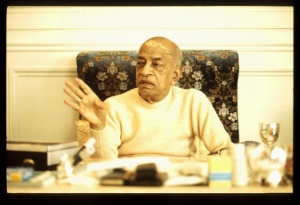SB 11.24.2

A.C. Bhaktivedanta Swami Prabhupada
Please note: The synonyms, translation and purport of this verse were composed by disciples of Śrīla Prabhupāda
TEXT 2
- āsīj jñānam atho artha
- ekam evāvikalpitam
- yadā viveka-nipuṇā
- ādau kṛta-yuge 'yuge
SYNONYMS
āsīt — there existed; jñānam — the seer; atha u — thus; arthaḥ — the seen; ekam — one; eva — simply; avikalpitam — undifferentiated; yadā — when; viveka — in discrimination; nipuṇāḥ — persons who were expert; ādau — in the beginning; kṛta-yuge — in the age of purity; ayuge — and before that, during the time of annihilation.
Translation and purport composed by disciples of Śrīla Prabhupāda
TRANSLATION
Originally, during the Kṛta-yuga, when all men were very expert in spiritual discrimination, and also previous to that, during the period of annihilation, the seer existed alone, nondifferent from the seen object.
PURPORT
Kṛta-yuga is the first age, also known as Satya-yuga, in which knowledge, being perfect, is not different from its object. In modern society, knowledge is highly speculative and constantly changing. There is often a vast difference between people's theoretical ideas and actual reality. In Satya-yuga, however, people are viveka-nipuṇāḥ, or expert in intelligent discrimination, and thus there is no difference between their vision and reality. In Satya-yuga, the population in general is self-realized. Seeing everything as the potency of the Supreme Lord, they do not artificially create duality between themselves and other living entities. This is a further aspect of the oneness of Satya-yuga. At the time of annihilation, everything merges to rest within the Lord, and at that time also there is no difference between the Lord, who becomes the only seer, and the objects of knowledge, which are contained within the Lord. The liberated living entities in the eternal spiritual world are never subject to such merging but remain forever undisturbed in their spiritual forms. Because they are voluntarily one with the Lord in love, their abode is never annihilated.